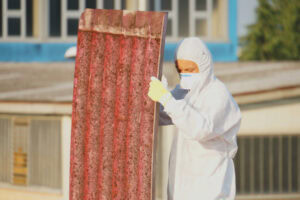Our asbestos removal services at U.S. Waste Industries are backed by over 150 years of combined experience in the identification, removal, and disposal of hazardous waste. Asbestos can be found in floor tiles, ceiling texture tiles, insulation, and fireproofing materials of even modern buildings. Asbestos-contaminated vermiculite insulation was used as recently as 1990. While some uses of asbestos have been banned by the EPA, asbestos-containing materials (ACM) are still used in some industrial applications.
Why Asbestos Removal Services Are Essential
If the presence of asbestos is suspected, customers should contact us before any renovation or demolition. Samples can be taken to confirm the presence of asbestos. Depending on the material and whether it is friable (likely to be inhaled), a remediation solution can be developed based on customer needs. Small amounts of asbestos may be encapsulated to prevent the fibers from entering the air. Encapsulation is fully sanctioned by the EPA and may be the most cost-effective solution, depending on the application.
If it is determined that the asbestos must be removed, all demolition is completed by trained experts and the asbestos is disposed of in accordance with all federal, state, and local regulations. Final documentation is provided for customer records as needed. For more information about our asbestos removal capability, see the table below, or contact us directly.
Asbestos removal is especially common in plant closures, retrofit structures, and abandoned properties.
Asbestos Removal Regulations
The regulations that govern asbestos removal cover the following processes:
- Required Inspections: For any demolition or renovation, the Occupational Safety and Health Administration (OSHA), EPA, and state regulations require an inspection to determine whether asbestos-containing materials (ACM) are present. The inspection also reveals the scope of the project and determines which regulations apply.
- Permissible Exposure Limits: Asbestos removal services often also invoke OSHA limits for airborne contaminants, especially when inspections reveal friable materials. OSHA 1910.1001 and 1926.1101 in particular outline numerous regulations related to airborne asbestos, including:
- Exposure monitoring
- Employee notification
- Prohibited activities (e.g., eating or drinking)
- Respirators and protective clothing
- Ventilation
- Clean-up and removal
- Removal Processes: Only licensed professionals may provide asbestos removal services, which must follow proper handling, containment, and disposal methods.
- Disposal: Asbestos is a hazardous waste material, requiring special arrangements for transportation and disposal at facilities designed to prevent environmental contamination.

